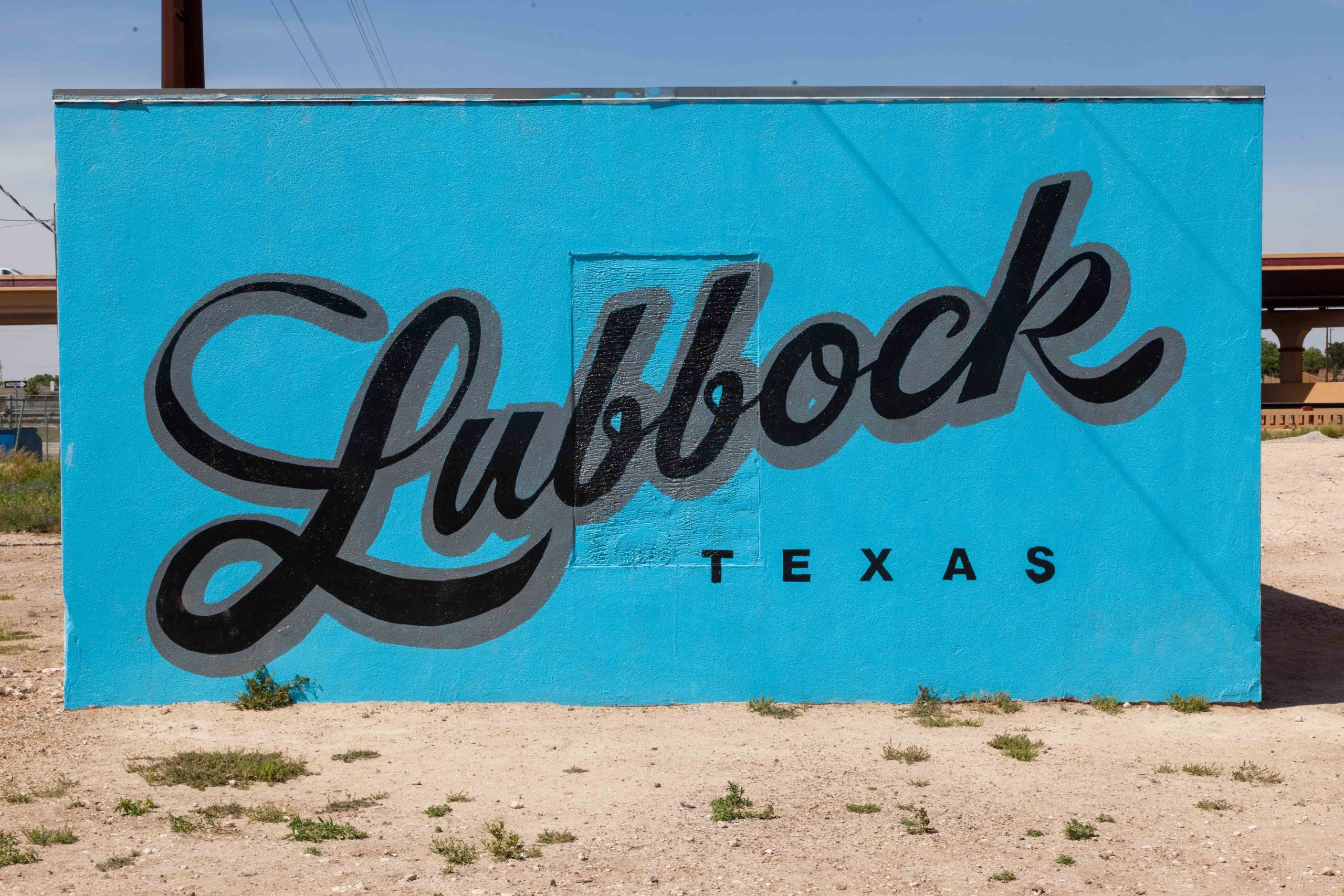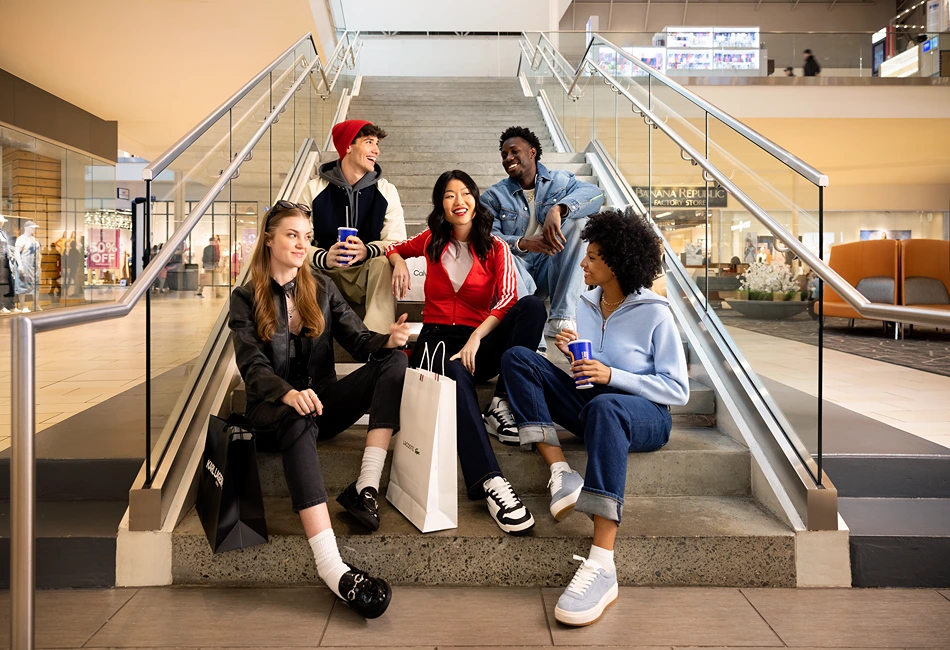A theater complex dedicated to the city’s favorite son has spurred downtown development and an active arts scene
Rock ’n’ roll pioneer Buddy Holly was a little bit before my time, but I knew his music growing up and could easily identify him by his signature horn-rimmed glasses. In the planning of my visit to the late singer’s hometown, sites associated with Lubbock’s favorite son topped my list of things to do.
Though the teen idol was popular for only a brief time before his untimely death in a plane crash in 1959, he made a huge impact on American music and forever will be remembered in this city on the High Plains of West Texas. I found plenty of Holly-related sites that satisfied my interest, places that meant something to me because I had just read an in-depth Buddy biography before the trip. Even people born long after the 1950s have probably heard Holly hits like “Peggy Sue,” “It’s So Easy,” “Everyday,” “Maybe Baby,” “Rave On!,” Oh Boy!” and “That’ll Be the Day.”
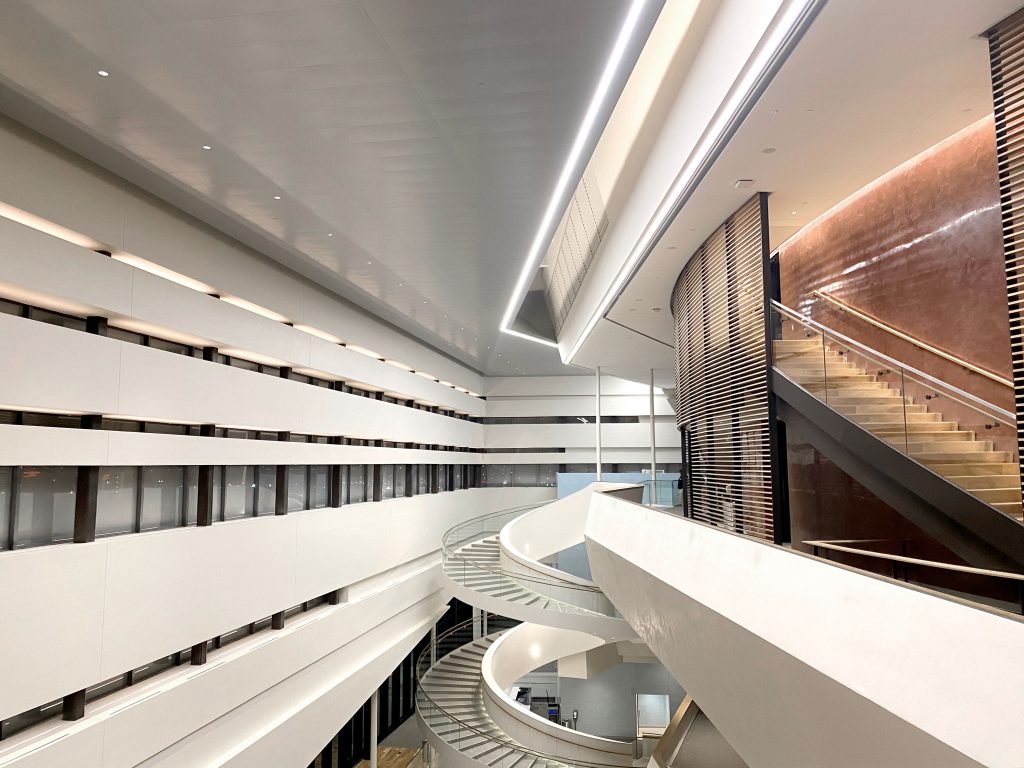
The Buddy Holly Hall of Performing Arts and Sciences. (Photo credit: Visit Lubbock)
A City on the Move
I also discovered a blossoming arts and culinary scene in Lubbock, a large city (pop. 263,000) that seems to sit by itself in the vast, treeless expanses of the Texas Panhandle, far away from better-known places to the east and south. Downtown is in the midst of a renaissance, a revival highlighted by the 2021 opening of the Buddy Holly Hall of Performing Arts and Sciences, a sparkling theater complex in a part of downtown that had languished for decades after a deadly 1970 tornado. The heart of town never fully recovered, but it’s been on the march ever since the hall’s 2013 groundbreaking. Anticipation of the high-profile venue’s completion proved to be the catalyst for economic development as businesses eyed the potential influx of people that would come downtown and spend money on a good time.
“With the memory of the devastating 1970 tornado at the forefront of our revitalization efforts, a neighborhood that sat dormant for over 50 years has flourished into a hub for entertainment and business,” said McKenna Dowdle, media relations and communications manager of Lubbock Economic Development Alliance (LEDA) & Visit Lubbock. “Since the announcement of The Hall, we have seen new hotel developments, dozens of business investments in the form of restaurants and retail shops, a higher education facility for a local community college, bike lanes and much more.”
Built with private funds by community members who wanted to bring the performing arts big-time to Lubbock, the state-of-the-art Buddy Holly complex holds a 2,297-seat main theater that attracts national touring shows. Its 2022-2023 Broadway season features Hairspray, Fiddler on the Roof, Dear Evan Hansen, Tootsie and Hamilton. The first Broadway production, staged during the hall’s January 2021 opening, was Buddy, a musical about the life of you-know-who. The 159-seat Crickets Theater, named for Holly’s band, hosts smaller performances. Both auditoriums are rated NC15, the highest acoustical rating.
The Buddy Holly Hall boasts a stunning, light-bathed lobby with a three-level, helical staircase that weighs 26,000 tons. The bar serves up cocktails named for Holly hits (like “It’s So Easy Lemonade”), and the hall’s restaurant is Rave On.
On the interior’s south wall, visible through the facade’s glass window, 9,000 aluminum guitar picks in 11 sizes form an art installation depicting Buddy’s hand strumming his Fender guitar. The hall’s logo incorporates a tornado’s funnel cloud, a nod to downtown’s rebirth and triumph over disaster.
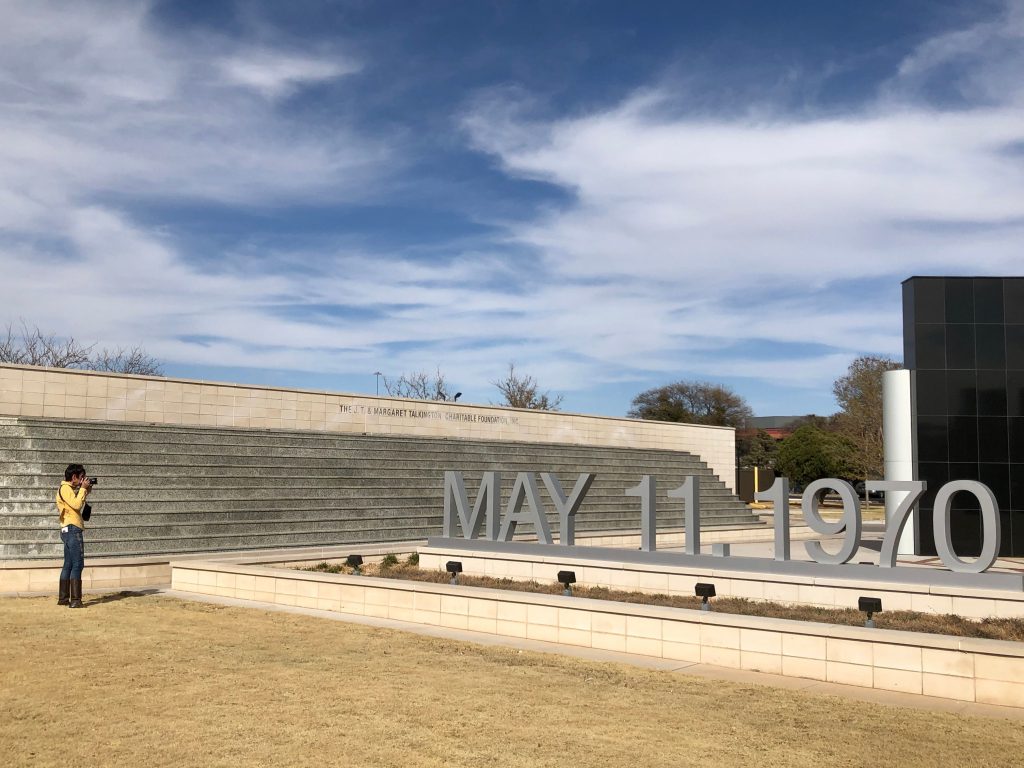
The Lubbock Tornado Memorial recalls a tragic event. (Randy Mink Photo)
To grasp the storm’s impact on the community, visit the new Lubbock Tornado Memorial, located a few blocks from the Buddy Holly Hall. The memorial was dedicated in 2021. Its black granite walls are inscribed with a chronology of the F-5 tornado, eyewitness accounts, recovery efforts and the names of the 26 dead.
The memorial serves as a gateway to Lubbock’s burgeoning Cultural District, where once-abandoned commercial and municipal buildings, some of them damaged by the 1970 tornado, have been repurposed as art galleries, studios and artist residences. LHUCA (Louise Hopkins Underwood Center for the Arts), just across from the Buddy Holly Hall, features two dozen traveling exhibitions throughout the year; admission is always free. At the Clay Studio, part of the LHUCA campus, ceramics classes are held (our group made vases there). The Graffiti Building, adorned with beautiful murals, ironically was once the place where the city stored equipment used to clean up graffiti. The adjacent plaza is a focal point for entertainment at the monthly First Friday Art Trail event, a celebration of art, music and food-truck fare that extends to other parts of town.

This whimsical mural in Lubbock’s Cultural District invokes the memory of Buddy Holly. (Randy Mink Photo)
Mural art can be found throughout the Cultural District. Two of the best selfie spots are the murals of Buddy Holly and famed Mexican artist Frida Khalo. The district’s Two Docs Brewing Co., started as a hobby by a doctor and veterinarian, features a Buddy Hoppy IPA.
A Shrine to Buddy Holly
True fans of the Lubbock music legend start their pilgrimage at the Buddy Holly Center, a museum that enshrines the rock ’n’ roller’s legacy. Not to be confused with the Buddy Holly Hall, it’s located in a former train station on Crickets Avenue in downtown’s Depot Entertainment District.
“Remembering Buddy Holly,” an 18-minute movie chronicling the singer/songwriter’s influence on a whole generation of rock musicians, features clips from interviews with Paul McCartney of the Beatles, Keith Richards of the Rolling Stones, Bob Dylan, Don McLean and Waylon Jennings, plus Holly’s widow, Maria Elena (who lives in the Dallas area). Holly is credited with introducing new sounds and innovations in both instrumentation and studio recording techniques. He had a whopping 25 hit records and actively toured for 18 months in a brief career cut short by the tragic plane crash that killed him and two other rising stars—Richie Valens and J.P. (The Big Bopper) Richardson—during a Midwest concert tour. Their small aircraft plunged into a farm field soon after takeoff on a snowy night in Clear Lake, Iowa. Holly was only 22.
Exhibits at the Buddy Holly Center include the famed glasses and Fender Stratocaster guitar recovered from the crash site. These pieces were returned to the family in the 1980s after having been stored away all that time in the evidence room of the sheriff’s office in Clear Lake.
Also on display are personal and promotional photos, items of clothing, and memorabilia relating to Holly’s family life and school days in Lubbock. The youngest of four children of Lawrence and Ella Holley, he was born Charles Hardin Holley on September 7, 1936, but went by the nickname “Buddy.” The “e” in Holley was accidentally dropped on his first recording contract, and the mistake was never corrected.

Visitors to the Buddy Holly Center like to pose with this reminder of the singer’s trademark glasses. (Randy Mink Photo)
In front of the museum, visitors can pose by a large sculpture of Holly’s trademark black-frame glasses. Next door is the home of Crickets drummer Jerry Allison. Furnished 1950s-style, the house was transplanted from its original Lubbock neighborhood. The band practiced in the modest abode, and it’s where Holly and Allison penned “That’ll Be the Day.” Group tours of the center’s Buddy Holly Gallery and Allison house can be arranged. (Allison today lives outside of Nashville, Tennessee.)
In a small park across the street from the Buddy Holly Center, a bronze statue of a guitar-playing Holly provides another good photo op. It anchors Buddy and Maria Elena Holly Plaza, home to the West Texas Walk of Fame.
For scouting out other Holly sites in town, the center offers a two-sided sheet with descriptions and addresses of schools Buddy attended, places where he performed and the home where he lived in 1957 (private). In City of Lubbock Cemetery, the headstone marking Holly’s grave bears a raised carving of his electric guitar.
The 1938 Cactus Theater is the magnet for live music in the Depot District. A former movie house on Buddy Holly Avenue, the venue presents top country and rock acts, plus tribute concerts saluting notables like Holly, Elvis Presley, Frank Sinatra and Lubbock’s Mac Davis, a country recording artist/songwriter/actor who had a national TV variety show in the 1970s. (The Buddy Holly Hall is on Mac Davis Lane.)
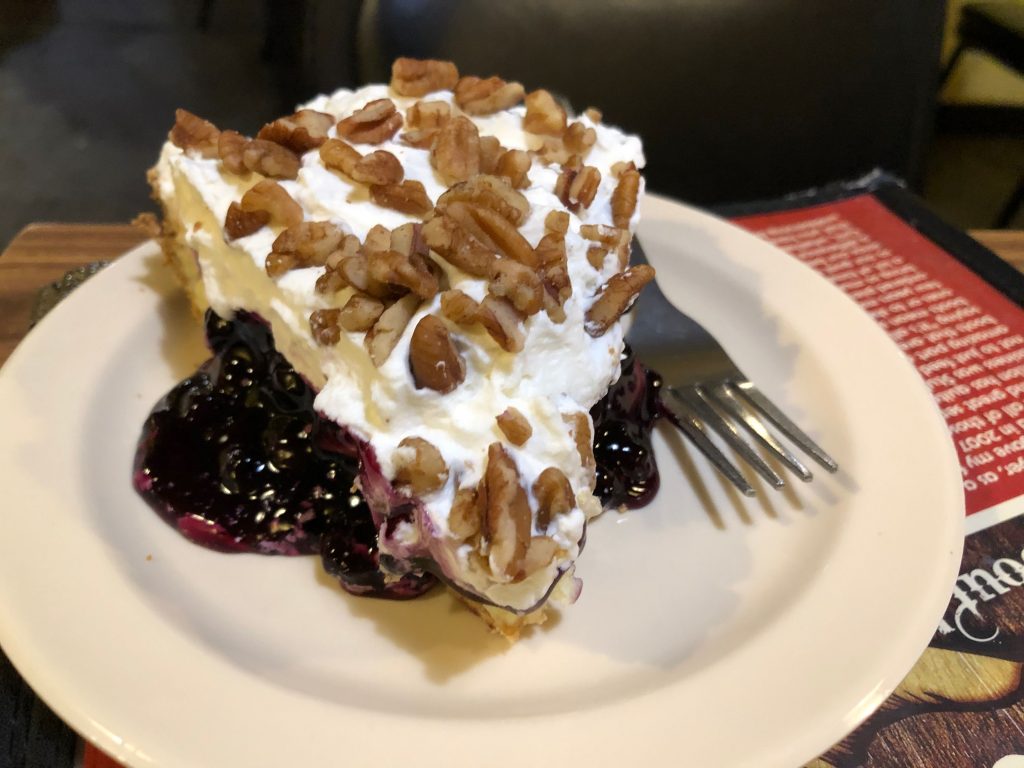
Cast Iron Grill’s blueberry banana split pie. (Randy Mink Photo)
Depot District Hot Spots
At Cast Iron Grill, next to the Holly Center, it’s not unusual to see regulars enjoying pie and coffee for breakfast. The place is famous for its variety of pies, which sell out daily. On Wednesdays, owner Teresa Stephens offers her famous blueberry banana split pie. A recipe from her husband’s family, it features a layer of creamy banana pudding and a graham cracker crust, with chopped pecans sprinkled on top. There are strawberry and cherry versions as well. She says her most popular pie is the Texas Delight, a square piece of heaven layered with whipped cream and chocolate mousse. Cowboy boots and Texas license places decorate the homespun eatery, and waitresses wear boots and shorts. Chicken-fried steak with white cream or green chile gravy is a breakfast/lunch favorite.
Spanish-style tapas, artisan pizzas and empanadas take center stage at the Depot District’s La Diosa Cellars. Housed in a former automotive garage, the restaurant is eclectically decorated with unusual light fixtures, works by artists representing different cultures and a warm inviting decor that reflects the Mexican heritage of owner Sylvia McPherson, an interior designer by trade. My favorite tapas were the Albondigas de Madrid, plump meatballs flavored with sweet onion, jalapeno and marsala wine sauce. And you can’t go wrong with the baked French brie or classic tapas like Tortilla Espanola (baked egg and potato with onion) and Antonio Papa Bravas (braised potatoes with tomato, Spanish chorizo, Swiss cheese and onion).
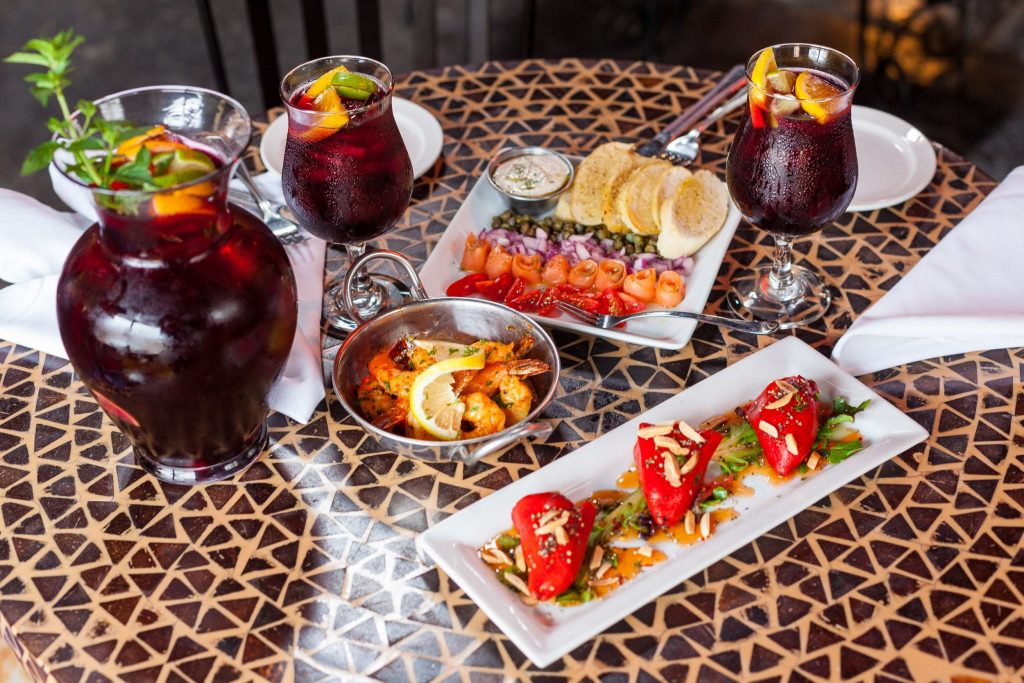
La Diosa Cellars specializes in Spanish-style tapas. (Photo credit: Visit Lubbock)
La Diosa’s delightful morsels can be washed down with wines from McPherson Cellars, a short walk away. Owned by Kim McPherson, Sylvia’s husband, the first producing winery in Texas occupies an old Coca-Cola bottling plant, and its private tasting room was once a garage for delivery trucks. Tours and tastings are available. Grapes for its wines come from an estate vineyard in Lubbock and vineyards in the neighboring county. Ken’s dad was Dr. Clinton “Doc” McPherson, a pioneer in the Texas wine industry. A chemistry professor at Lubbock’s Texas Tech University, Doc started making wine in the school’s lab in the early 1970s.
Many in my group were surprised to learn that 92 percent of the grapes used in Texas wine production are grown in vineyards within a 30-mile radius of Lubbock. When the subject of Texas wines come up, most people think of the many wineries in Fredericksburg and Texas Hill Country, but the semi-arid Lubbock area does all the dirty work. Most vineyards in the Texas High Plains AVA (American Viticultural Area) are on flat terrain at an elevation of 3,000 to 4,000 feet. More and more farmers in the region are switching from cotton to grapes, as the latter requires one-third less water.
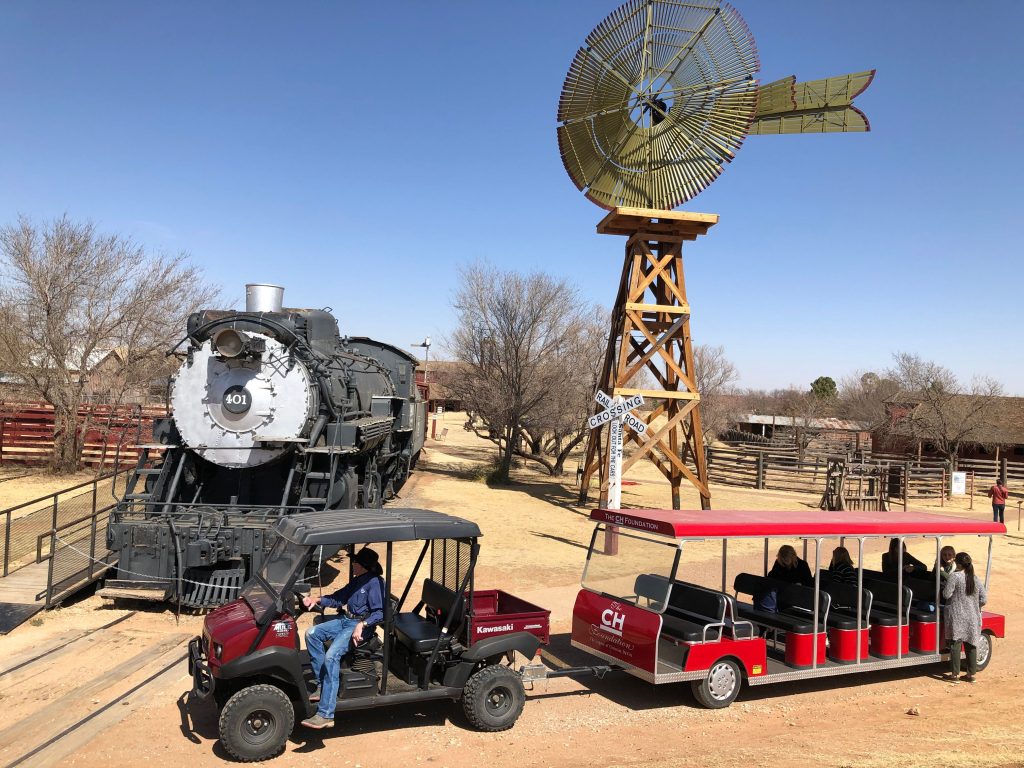
The National Ranching Heritage Center, one of Lubbock’s prime attractions, offers trolley tours. (Randy Mink Photo)
High Plains Heritage
Here in the heart of the Texas Panhandle, the terrain is flat, flat, flat. The horizons seem to stretch forever. Many landscapes are dotted with cattle, as ranches and cowboys still play a big part in West Texas life.
The free-admission National Ranching Heritage Center, an outdoor complex on the northern edge of the Texas Tech campus, sheds light on the history of ranching in North America. Following a 1.5-mile pathway through the 19-acre park, visitors see 55 transplanted ranch structures, most of them from Texas and many over 100 years old. They include a cowboy bunkhouse and cookhouse, barns, windmills, a blacksmith shop, a one-room schoolhouse and a country church. There’s even a cow chip house. Groups can arrange a chuckwagon meal in the pavilion and reserve the 21-seat, open-air trolley for a narrated tour through the park, whose buildings are furnished for period correctness and arranged chronologically to show the evolution of ranch life starting in the late 1700s. Indoor exhibit galleries showcase Western art and artifacts.
The sprawling Texas Tech campus, home to 40,000 students, claims one of the nation’s top 10 university public art installations. One percent of the estimated budget for any new capital project or major renovation must be set aside for a piece of public art. Coordinated to match the function of the building, the sculptures, paintings and murals are site-specific works created by leading contemporary artists. A dramatic stainless steel depiction of five female track athletes in motion, for example, stands outside the TTU Sports Performance Center. The Lubbock campus has 87 of the 101 artworks in the Texas Tech system. Highlight tours on the Art Cart, an electric golf cart seating up to 12 passengers, are given, or a step-on guide may come aboard the group’s bus. There is no charge for tours.
An iconic symbol of America’s agricultural roots and life on the Great Plains captivates visitors to Lubbock’s American Windmill Museum, the largest such museum in the world. Consisting of a 28-acre park scattered with working windmills and two cavernous buildings exhibiting restored windmills dating back to 1879, the attraction spotlights the key role these pumping machines played in supplying farms with water.
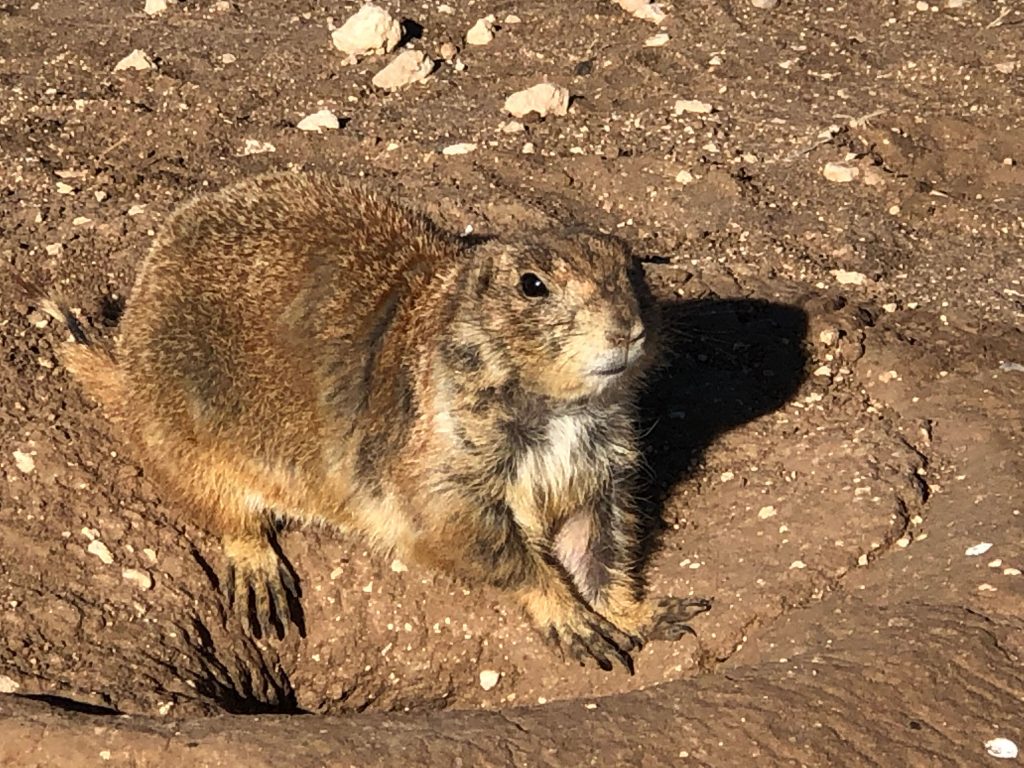
Prairie Dog Town. (Randy Mink Photo)
Animal lovers gravitate to Prairie Dog Town in Mackenzie Park. Another example of life on the Plains, the protected prairie dog colony was conceived and designed by a man who wanted to save the black-tailed prairie dog from extinction when he learned that a government program to poison the little critters was proving effective. From behind the enclosure’s wall, people feed them carrots and other food items when they venture from their network of burrows. (The animal is not a dog but rather a ground squirrel named for its barking call.)
Latest Downtown Developments
Despite the pandemic’s effects on the American economy, much has happened to enliven downtown Lubbock during the last two years. On Broadway, the brick-paved main drag, the 165-room Cotton Court Hotel, opened in September 2020, combining retro vibes with contemporary flair. In nods to the region’s cotton-growing heritage, one side of the resort-style property resembles a brick-walled cotton warehouse, while corrugated steel in another part mimics a cotton gin. Guest room doors are patterned after loading docks, and design touches with an industrial feel accent the comfy nests. Guests can relax in rockers on the sweeping porches outside their room or recreate in the festive courtyard, a gathering space with fire pits, fireplaces, hammocks, cornhole and Jenga games, a heated pool and trees festooned with twinkly lights. There’s live music on weekends.
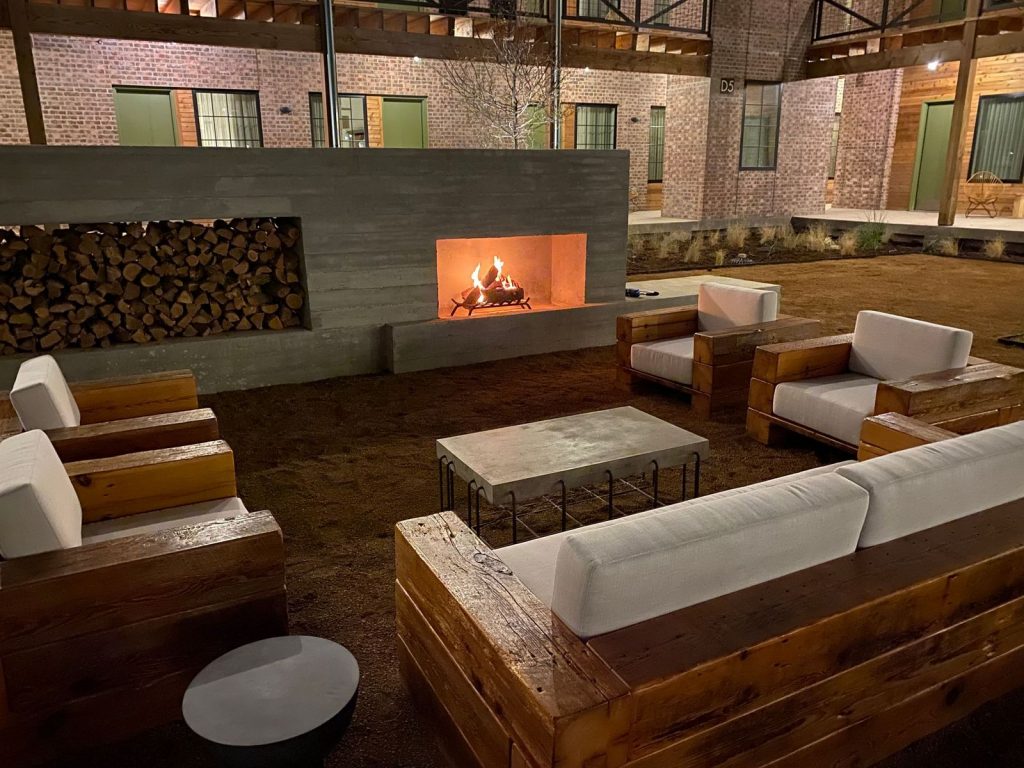
The Cotton Court Hotel’s courtyard is an inviting place to relax. (Photo credit: Valencia Hotel Group)
Cotton Court design elements also invoke Lubbock’s music history. Point your phone’s camera at the wall above the lobby and you’ll recognize a dot image of Buddy Holly’s face next to a cotton exchange trading board. You can check out a free guitar from the front desk and strum away. The hotel’s restaurant and bar, Midnight Shift, is named for a Holly song.
Also opening their doors in 2020 were two other downtown restaurants. Dirk’s is a diner-style spot known for its various styles of chicken strips (Nashville hot chicken was my favorite) with dipping sauces and choices of scrumptious sides like cheddar grits, fried okra, collard greens and gumbo. The same chef, Cameron West, operates The West Table Kitchen and Bar and The Brewery LBK in a landmark building on Broadway. The unassuming, small-batch brewery made No. 1 in USA Today’s list of Top 10 Brewpubs in the U.S. Just down the street, Burklee Hill Vineyards, a great place for lunch, dinner or just wine tasting, is an upscale bistro in the old Kress variety store. Since 2002, the Hill family has been growing grapes on land it has farmed for five generations.
A survey of new downtown restaurants is incomplete without mention of The Nicolett, a sophisticated dining destination featuring the exquisite creations of Chef Finn Walter, a 2022 James Beard Foundation semifinalist in the category Best Chef: Texas.

Evie Mae’s Pit Barbecue. (Photo credit: Visit Lubbock)
If I had to choose one place to eat, though, it would be Evie Mae’s Pit Barbecue. Located in Wolfforth, just outside the Lubbock city limits, Evie Mae’s ranked No. 8 in Texas Monthly’s list of Top 50 BBQ Joints in Texas. For sandwiches or meat plates, choose from brisket, smoked turkey, pulled pork, ribs and sausage. Special treats are the green chile sausage and green chile cheese grits, which reflect the New Mexico upbringing of owners Arnis and Mallory Robbins. But I would go there just for the spicy smoked-brisket chili, and I loved both the regular and jalapeno cornbread. Decadent desserts include cobblers, banana pudding, pies and Texas sheet cake, a chocolate cake topped with chocolate frosting and nuts.
Group tour planners may request information from Visit Lubbock.
—By Randy Mink, Senior Editor
Lead photo courtesy of Visit Lubbock

